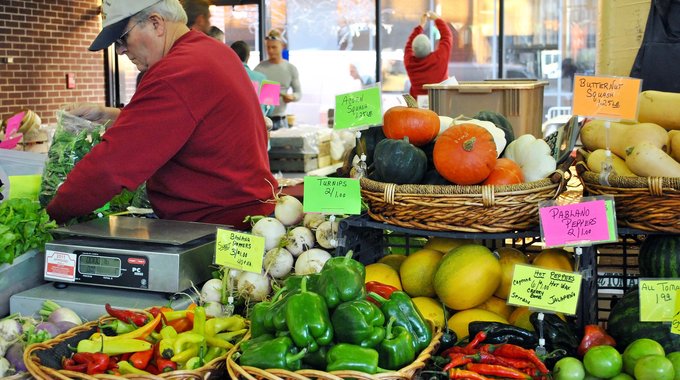In honor of National Farmers Market Week (this year, August 6 to 12), we’re recognizing the extraordinary markets that LISC has helped launch, grow and support, and how much good they bring to their communities.
For all their liveliness and colorful abundance, there’s much more to farmers markets than meets the eye. They create access to affordable, fresh, locally-grown food, and provide important public gathering space. They also help restore a crucial link between rural and urban America, promote the health of the environment, and stimulate small business and local economies. Farmers markets create 13 full-time jobs for every $1 million of revenue. And growers selling locally return three times more revenue to the community than do chain food stores.

Because farmers markets are such an effective tool in community and main street revitalization, LISC supports more than 100 around the country, through our local offices and rural program and with assistance from our national healthy food initiative. In Rhode Island, for instance, one of our partners, Farm Fresh, represents 55 markets throughout the state. Our rural partners promote small-town markets in Louisiana, Oregon, Massachusetts and Florida. And we back urban markets near affordable housing and community services everywhere from Houston to Indianapolis to New York City, as with the Pitkin Verde Farmers Market where local growers sell produce under the eaves of a health clinic in Cypress Hills, Brooklyn.

The Flint Farmers Market in Michigan is one flourishing example of what a market can do. In 2013, LISC provided a $1 million loan to help expand and relocate the market to a new “health and wellness district” downtown (formerly a federally-designated food desert), adjacent to the city’s transit center. This has made shopping for healthy groceries especially convenient for people using public transportation (a transit study showed that more than 65% of Flint households do not own a car).
More than $80,000 in LISC Section 4 grants also made it possible for support staff to kickstart and manage the market’s new incarnation.


Today, the energy-efficient building, which added a soaring, 70-foot atrium to a conversion of the abandoned Flint Journal Printing facility, is a welcome addition to the downtown cityscape, and a dynamic cog in its renewal. Open year-round, the market now serves as an indoor town square, a place for bumping into old acquaintances and making new ones. There are more than 50 vendors selling food grown and produced locally and in surrounding Michigan counties. A commercial kitchen serves as a culinary business incubator where food entrepreneurs can develop a product idea all the way from field to market. And there’s ample space for everything from community meetings and performances to nutrition and exercise classes.

In partnership with public and private healthy eating initiatives, the market also offers financial incentives for people to mix more fresh produce into their diets. Most vendors accept SNAP or food stamps, and “Double-Up Food Bucks” enable eligible mothers of young children to double the amount of fruits and vegetables they purchase.


In other cities and rural areas across the country, LISC-backed farmers markets are supporting small-scale agriculture, revving up local commerce and social interaction, and getting more nutritious food onto the plates of residents–all indispensable ingredients of a healthy community.